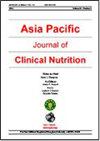Effects of fructose from apple and honey on serum uric acid in young Chinese: Randomized crossover trials.
IF 1.3
4区 医学
Q4 NUTRITION & DIETETICS
Asia Pacific journal of clinical nutrition
Pub Date : 2022-03-01
DOI:10.6133/apjcn.202203_31(1).0010
引用次数: 1
Abstract
BACKGROUND AND OBJECTIVES Overconsumption of drinks containing fructose increases the risk for hyperuricemia and gout. Comparative analysis evaluating the indicators of serum uric acid (SUA) load caused by natural food-derived fructose and pure fructose in sweeteners is lacking. We aimed to uncover the effect of fructose from apple and honey and pure fructose powder on the SUA concentration of healthy young Chinese individuals. METHODS AND STUDY DESIGN Two randomized crossover trials were performed. The participants were randomly assigned to consume apple or honey (test food) or pure fructose powder (reference food); one week later, the groups' dietary intervention was switched. Blood samples were collected at 0, 30, 60, and 120 min after meal to measure the SUA and blood glucose concentrations. RESULTS At 30 and 60 min, the SUA concentration in participants consuming apple or honey was lower than in those consuming fructose powder. At 120 min, the SUA concentration of participants consuming apple returned to baseline. The areas under the curve (AUC) within 2 h (2h- AUCs) of SUA exhibited the trend of fructose >honey >apple. The 2h-AUC ratio between test food and reference food was determined using the uric acid index to assess the efficiency of food-derived fructose in increasing the SUA concentration. The uric acid index of honey was higher than that of apple. Men had higher postprandial SUA concentration than women. CONCLUSIONS Food-derived fructose caused a lighter load on uric acid metabolism than pure fructose. Uric acid index can be useful for distinguishing fructose-containing foods.苹果和蜂蜜果糖对中国年轻人血清尿酸的影响:随机交叉试验。
背景与目的过量饮用含有果糖的饮料会增加患高尿酸血症和痛风的风险。缺乏评估甜味剂中天然食品衍生果糖和纯果糖引起的血清尿酸(SUA)负荷指标的比较分析。我们旨在揭示苹果和蜂蜜中的果糖以及纯果糖粉对健康中国年轻人SUA浓度的影响。方法和研究设计进行两项随机交叉试验。参与者被随机分配食用苹果或蜂蜜(测试食品)或纯果糖粉(参考食品);一周后,两组改变了饮食干预。在餐后0、30、60和120分钟采集血样,以测量SUA和血糖浓度。结果在30和60分钟时,食用苹果或蜂蜜的参与者的SUA浓度低于食用果糖粉的参与者。在120分钟时,食用苹果的参与者的SUA浓度恢复到基线。SUA作用2h内的曲线下面积(AUC)呈果糖>蜂蜜>苹果的趋势。使用尿酸指数测定试验食品和参考食品之间的2h AUC比率,以评估食品衍生果糖在增加SUA浓度方面的效率。蜂蜜的尿酸指数高于苹果。男性餐后SUA浓度高于女性。结论:与纯果糖相比,食物来源的果糖对尿酸代谢的影响较小。尿酸指数可用于区分含果糖的食物。
本文章由计算机程序翻译,如有差异,请以英文原文为准。
求助全文
约1分钟内获得全文
求助全文
来源期刊
CiteScore
2.50
自引率
7.70%
发文量
58
审稿时长
6-12 weeks
期刊介绍:
The aims of the Asia Pacific Journal of Clinical Nutrition
(APJCN) are to publish high quality clinical nutrition relevant research findings which can build the capacity of
clinical nutritionists in the region and enhance the practice of human nutrition and related disciplines for health
promotion and disease prevention. APJCN will publish
original research reports, reviews, short communications
and case reports. News, book reviews and other items will
also be included. The acceptance criteria for all papers are
the quality and originality of the research and its significance to our readership. Except where otherwise stated,
manuscripts are peer-reviewed by at least two anonymous
reviewers and the Editor. The Editorial Board reserves the
right to refuse any material for publication and advises
that authors should retain copies of submitted manuscripts
and correspondence as material cannot be returned. Final
acceptance or rejection rests with the Editorial Board

 求助内容:
求助内容: 应助结果提醒方式:
应助结果提醒方式:


